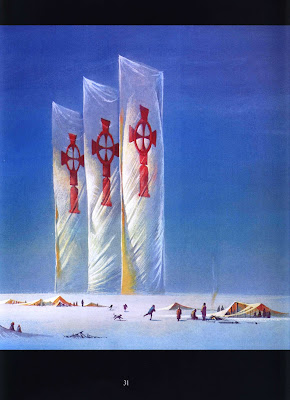Future Prophecies from Nostradamus' Ancient Writings
by Bruce Pennington
I'm surprised that nostalgia hadn't motivated me to pick the book up since those long-ago days, but I recently did, indeed, get a copy; these can be had from the usual used book vendors online for reasonable prices.
'Eschatus' (78 pp) was published in the US in 1977 by Fireside / Simon and Schuster. At 12" x 12" it's a large, well-made book with good quality reproductions, most of which are too large for me to scan in their entirety.
'Eschatus' is indeed a Stoner-friendly art book, one that perfectly captures the strange obsession with prophecy and the apocalypse that was a big part of 70s pop culture (remember Hal Lindsey's Late Great Planet Earth books ? Or the Omen movies ?
Most of the quatrains that Pennington has selected to illustrate are those that - for him, at least - prophecy disasters of apocalyptic scale, giving rise to landscapes of ruination, destruction, and mass deaths.
Pennington interprets some quatrains as predicting the rise of a militaristic New World Order akin to those of Nazi Germany and Soviet Russia.
Nostradamus's poetry lends itself well to interpretations of a symbolic, rather than realistic, nature:
Pennington's work is clearly inspired to some extent by the paintings of Salvadore Dali:
The final quarter of the book is made up of several pages of lists of phrases appearing in Nostradmus' poems, phrases which Pennington used to guide his compositions.
Summing up, 'Eschatus' is worth picking up if you are a fan of Pennington's art, fantastic art in general, or.....if you are a stoner and looking for some art that goes well with being stoned - !



























































.jpg)



















